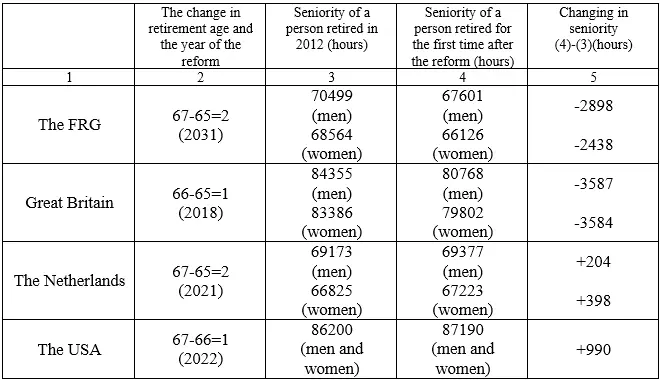Such measures are connected to demographic reasons, first of all. For example, in 2012 in the FRG the population aged over 65 years old was 34.8% of the number of able-bodied people, in Great Britain it was 28.9%, in the Netherlands it was 27.3%, in the USA it was 22.8%. At that, for all the above countries the life expectancy of people at age 65 exceeded 19 years [43]. Slowing tempos of increasing in social labour productivity typical for European countries down is taken into account too [44].
Obviously, it is about prolongation of nominal seniority for employees who are to retire according to the new legislation. Prospects of comparative changing in the value of their actual seniority require additional examination.
Let us use the following calculation: time actually worked by those who are to retire after increasing in retirement age by 2012 is added with the product of the number of years since 2012 till the year of enactment of the new retirement age and the average number of hours worked during 2012 per one employee in a certain country. At the same time, the difference in average effective retirement of women and men must be taken into account. The results of these calculations are at table 52.
So, prolongation of nominal seniority for 1-2 years does not always mean increasing in actual relative seniority of those who retired at earlier ages.
In case of the FRG and Great Britain prospects of reduction of the average number of working hours are seen, and this reduction is equivalent to their volume worked at present state of affairs during 1.5-2 years.
Table 52
Prospects of Changing in Actual Seniority in Conditions of the Pension Reform in Economically Developed Countries

Source : calculated according to the data of the OECD
Possible growth of actual seniority relative to seniority of employees retired in 2012 is less than 30% of the annual working time value in the Netherlands, in the USA it is a little bit more than 50%.
This divergence of the dynamics of nominal and actual seniority has an explanation. Seniority of those who retired for the first time after the reform covered the period closer to the present. Within it the total number of working hours was less than it had been in the period of working activities of pensioners in 2012.
The above calculations are made at the prerequisite that since 2012 till the moment of an increase in the border of the retirement age the average number of working hours per one employee per year will be constant. If decreasing in this number continues, then the value of actual seniority of present employees will be less than predecessors’ value in the FRG and Great Britain. In the Netherlands it will reduce and be approximately equal at these two age-related cohorts of employees in the USA.
Thus, increasing in the retirement age for new generations of employees can be combined with reduction of employees’ actual seniority. Exceeding cumulative effect from reduction of a working day (week, year) within more enduring nominal seniority over growth of hours worked during additional years of working activities is a condition of this combination. This combination is consistent with the regularity of working time reduction and free time increasing of employees and, consequently, with requirements of economic development.
Of course, one should not idealize the existing form of realization of this regularity. Differentiation in duration of time of full-time and part-time employees is hidden behind average numbers of working time. This differentiation is also typical for wages when a significant part of employees is on the brink of material well-being. It explains the negative attitude of trade unions to such pension reforms.
In the made analysis it was supposed that the level and dynamics of nominal seniority – duration of the ability to work period – are independent of similar characteristics of actual seniority – the total number of working hours within nominal seniority. It is necessary to take into account the connection between them too.
This connection is quite understandable: daily workload of an employee, conditions of his labour essentially influence the period of preservation of the ability to work and, in general, life span.
For example, during the period of classical slavery in ancient Rome slaves were able-bodied during 15-16 years, while modern industrial employees are able-bodied for 40 years. This multiple difference cannot be understood if we do not take into consideration that at 14-16-hour daily labour slaves worked for more than 80000 hours during their working life what is commensurable with actual seniority of industrial employees of the modern economically developed countries.
Researches show that reduction of the average annual working hours per one employee by 200 hours leads to a 1 year increase in the life-expectancy in a country [45]. At that, undoubtedly, the period of the ability to work increases too. As a result, reduction of actual seniority assists in increasing in nominal seniority.
The opposite – attempts to increase nominal seniority without reduction of actual seniority – would contradict the objective logic of economic development, would mean enforcing labour beyond the ability to work age with all negative consequences (reduction of employees’ life span, their floating away from the production sphere, etc.).
When determining the dynamics of nominal seniority, it is necessary to take into account that work of industrial employees is done in less favorable conditions than work of employees rendering services. Substantial differences in duration of the actual period of ability to work, which is shorter at industrial employees, follow from here.
In these conditions appropriateness of using the same age for retirement is doubtful, especially as workers, as a rule, begin their labour activities earlier than those who get a higher education. If the same retirement age is oriented towards the limit of ability to work of industrial employees, then nonproduction employees fall into a privileged position, having an opportunity to retire, being able-bodied actually. And if the value of nominal seniority is oriented towards a working life of people occupied in the services sphere then industrial employees are forced to work beyond the ability to work age: their working potential decreases, work turns to be an active factor of poor health and early death. There is the objective need for differentiation of the retirement age and normal duration of seniority for people occupied in basic spheres of the economy.
Enactment of 6-hour and less enduring shifts assists in increasing in the ability to work period of industrial employees, in this respect, it brings their position together with the position of employees of the nonproduction sphere.
Taking into account the existing potential of economic development it is not enough to assess prospects of reduction of the number of hours worked during a working life from the dynamics of a working day and other periods of working activities. The effect of transition to 6-hour shifts should be considered.
To assess this effect let us use the following way of its calculation. Using the data of table 23 about the average annual number of working hours per one industrial employee, let us calculate the similar index in conditions of transition to a 6-hour working day, as applied to each year of nominal seniority corresponding to the value of seniority in 2012. To do it we shall successively decrease the value of working time in the previous year by the value of average annual reduction of working time per one employee (the last value is calculated according to the data of table 51 by means of dividing annual labour saving by the number of people occupied in production).
Читать дальше













